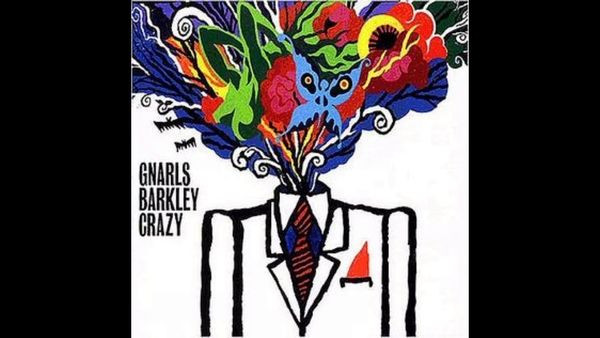How do you even begin to understand the magic of Gnarls Barkley’s “Crazy”? This track, famously recorded in a single take, emerged from the minds of two artists who were still finding their collaborative rhythm. It’s a song that feels almost divinely inspired, a spontaneous burst of creativity where everything aligned perfectly, resulting in something truly unique and arguably impossible to replicate. “Crazy” isn’t just a catchy tune; it’s a cultural phenomenon, a song that continues to resonate deeply with listeners worldwide.
Released to the world in 2006, “Crazy” has a strong claim to being the defining pop song of the 21st century. But beyond its infectious melody and global appeal, it offers something even more profound: a strikingly accurate portrayal of the complexities of mental health. For someone who has navigated the challenges of obsessive-compulsive disorder (OCD) since childhood, “Crazy” hits with a particular force. While songs like Radiohead’s “No Surprises” capture feelings of anxiety and despair, and Pink Floyd explored the darker sides of mental states, “Crazy” uniquely encapsulates the feeling of OCD itself. This isn’t to position Gnarls Barkley as experts on mental health, but rather to highlight the song’s uncanny ability to articulate a very specific and often misunderstood experience.
“Crazy” doesn’t just describe the negative aspects of mental struggle; it delves into the nuanced and sometimes paradoxical nature of conditions like OCD. CeeLo Green’s vocal performance is nothing short of transformative. His voice isn’t just singing lyrics; it’s reaching into the deepest parts of your consciousness, commanding attention and demanding to be heard. Just like the iconic single art – a head exploding in vibrant colors – the song’s orchestration feels like a symphony of the mind, a chaotic yet beautiful representation of the myriad processes firing within our brains. OCD can be overwhelming, a mental noise that drowns out the world. But “Crazy” offers an alternative perspective, a glimpse into the captivating, even beautiful, inner world that can exist within the same mind. It’s like tapping into the subconscious and finding not chaos, but a strange, compelling order.
 Gnarls Barkley Crazy Single Art
Gnarls Barkley Crazy Single Art
The brilliance of “Crazy” lies in its minimalist construction. Danger Mouse masterfully crafts a soundscape with just a few key ingredients: a distinctive, plucked bassline, samples evoking classic spaghetti westerns, and a straightforward, yet powerful drum loop. Danger Mouse, known for his genre-bending creativity and early internet savvy with The Grey Album, blends the vintage and the contemporary seamlessly. This fusion is central to “Crazy’s” appeal. It sounds both timeless and utterly modern, clean and polished yet with a raw, almost dusty texture. It’s a pocket-sized symphony delivered through a hip-hop lens. CeeLo Green, known for his rap roots, fully embraces his soulful side, channeling 1970s soul icons like Al Green, but with an edge, as if infused with a psychedelic energy. His unpolished, one-take vocal delivery enhances this feeling of raw, unfiltered emotion. “Crazy” unfolds like a stream of consciousness, a conversation within the confines of his own complex mind. As the cinematic strings swell in the chorus, there’s a sense of being on the brink, a feeling of exhilarating precariousness.
For those who experience intense anxiety or OCD, there can be a physical manifestation of mental distress. It can feel like a tightening, a pressure in the skull, a fear of reaching a breaking point. CeeLo’s lyrics, “I remember when, I remember when I lost my mind / There was something so pleasant about that place,” are particularly striking. They evoke a sense of a hidden space within, a place that feels both dangerous and alluring. It’s the fear of losing control, of falling into a mental abyss, yet also a strange curiosity about what that space might hold – a kind of Inception-like limbo where reality blurs. The song’s questions – “Do your emotions have an echo in so much space?” “Do you really think you’re in control?” – resonate deeply with anyone grappling with the power of their own mind.
OCD, in its most challenging form, is a stark reminder of the mind’s immense power. It can drive compulsive behaviors, irrational rituals, and decisions that seem illogical from the outside. This raises the question: if the mind can exert such control, could it potentially take complete control? “Crazy” was born from a conversation between Danger Mouse and CeeLo about the perceived link between artistic genius and madness. This idea sparked a deeper exploration of mental health, which became a central theme for Gnarls Barkley. The song’s music video, with its Rorschach-inspired animation, visually represents this exploration of perception and the subconscious. Their debut album, St. Elsewhere, named after the ‘80s medical drama, further delved into themes of depression and mental instability. Tracks like “Smiley Faces” explored the masks we wear to conceal inner turmoil, while “Boogie Monster” confronted the internal demons that haunt us. While their second album, The Odd Couple, followed in 2008, Gnarls Barkley never quite escaped the monumental shadow of “Crazy.” Danger Mouse shifted towards collaborations with artists like Norah Jones and U2, while CeeLo Green pursued mainstream pop success.
Popular culture, particularly movies and television, often simplifies or misrepresents OCD, reducing it to quirky habits rather than recognizing it as a serious anxiety disorder. The misconception persists, even in professional settings, where someone with a focus on detail might be flippantly asked if their OCD is “beneficial.” This trivializes a deeply challenging condition. This is why “Crazy” offers such a powerful form of solace. Two seemingly unconventional artists, who named themselves after a basketball player somewhat randomly and were known for their eccentric style, created a song that, in under three minutes, captured a complex inner experience with profound accuracy. And the world embraced it. That’s the truly “crazy” and wonderful nature of pop music – its ability to connect us, to validate our experiences, and to make us feel understood, even in our most vulnerable moments.
